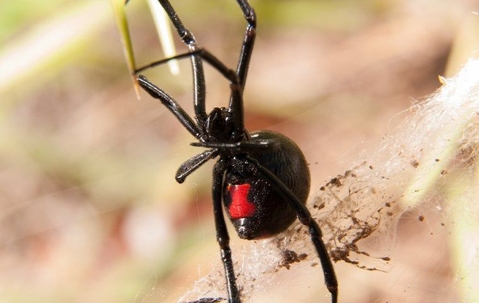When you feel a sticky spider web across your face or hands, you immediately wonder if the spider is on you, and because you live in San Mateo, you may be fearful that the spider is a black widow. There are three known types of black widow spiders in North America. The species commonly found in San Mateo is the western black widow (Latrodectus hesperus).
There are many questions and fears about black widow spiders in San Mateo. Pacific Pest Management, the San Mateo pest control experts, is here to help answer your concerns and eliminate black widows from your home.
What Does A Black Widow Spider Look Like?
As the name implies, the shiny body of an adult black widow spider is black. When they mate, the female spider eats the male spider, hence the "widow" part. The distinguishing mark of a black widow is the hourglass on the underside of the black abdomen. The unique signature consists of two triangle-like reddish markings joined together. Separate from the hourglass mark is another red dot near the spinnerets. Black widow spiders have eight eyes and legs. Female spiders are roughly one-third larger than males. When the legs are extended the female black widow has a measurement of about 1 1/2 to 2 inches.
Are Black Widow Spiders Dangerous?
When not in their webs, the western black widow will rarely bite, nor is it aggressive. If a black widow were to bite you, it would likely be the female spider who had recently laid her eggs.
Although they rarely bite, there can be consequences when they do bite. Black widow spiders are unique from other venomous creatures in that they have venom not only in the venom glands but also throughout the rest of the body.
Typically, it is the female who will bite when feeling threatened. Purportedly more potent than the venom of rattlesnakes, cobras, and coral snakes, these venomous spiders in California release neurotoxic venom through the long hollow fangs into its victim. The male black widow can bite and inject venom, but it does not inject it as deeply into the skin. When compared to the female, the male does not release as much venom into its prey. Although the toxicity of a black widow's venom is high, the amount it injects rarely causes death in healthy human adults.
Although rarely deadly, there are effects from a black widow spider bite. Common symptoms of a black widow bite include:
- Fever
- Sweating
- Nausea
- Cramping
- Muscle pain
- Chest pain
- Breathing difficulty
- Swelling in hands, feet, and eyelids
The pain from the venom is immediate, but it subsides in three hours or less; residual pain from the bite may last up to three days.
Can Black Widow Spiders Jump?
No, these very scary spiders do not jump. Black widow spiders and jumping spiders have small, black bodies causing people to confuse the two species. Although black widows are fantastic at climbing, their legs do not have the muscle structure or strength to enable them to jump.
How Can I Get Rid Of The Black Widow Spiders Lurking In My Home?
Here are a few things you can do to minimize your risk of coming into contact with a black widow spider:
- Remove clutter in your basement and garage.
- Wear heavy gloves and clothing when working in areas with spider webs.
- Wear heavy gloves when moving items stored for long periods.
- Store outdoor firewood at least 20 feet away from the house.
- Shake out shoes before putting them on.
The best protection you can give yourself is to secure the professionals at
Pacific Pest Management. We are your trained experts in spider removal. Reach out to us today and let us eliminate your spider problem and to learn more about our home pest control and commercial pest control services.

